American Instrument Technologies, Inc.
4408 Hungary Glen Terrace Richmond, VA 23294
American Instrument Technologies, Inc. (AIT, Inc.) was founded in June 1998 and has been registered at the State of Virginia, in the United States. AIT, Inc. has long been collaborated with the scientists and professors in American Biomedical Technology Research Institute (ABTRI) and Virginia Commonwealth University to design, patent and market medical devices mainly for patient health monitoring and management markets. The company employs the state-of-the-art biomedical electronics, biomedical communication, information technologies, bioinstrumentation and microcomputer and the Internet technologies to research and develop the devices and systems for early detection and remote monitoring of cardiovascular diseases, which is humans’ leading killer in the world; to research and develop medical devices and systems for remote monitoring humans’ health parameters and providing tele-healthcare for elderly patients, patients who need long-term care or patients who live in the area that no medical providers are easily accessed.
1THE MAJOR PROJECTS AND PRODUCTS AIT HAS DEVELOPED
I.PC-based Electrocardiogram (PC-ECG) series and the Internet-based remote monitoring system for early detection of cardiac diseases
Cardiovascular disease is the number one killer of the people living in the United States and other developed countries. According the report of American Heart Association, in 2006 there were more than 81 millions people in the United States have one or more forms of cardiovascular disease and the final mortality or death caused by cardiovascular disease was 34.3 percent of all deaths in the united states.
Electrocardiogram (ECG) is the major method used for diagnosis of heart disease. Great effort has been devoted to the development of high quality ECG machine in order to improve the accuracy of diagnosis. Yet, difficulties still exist in the diagnosis and treatment of heart disease, especially in the early detection of heart disease.
At first, ECG test is normally not performed on routine base. Even for people who routinely visit their physicians for yearly check ups. In most cases, ECG test is performed only for patients complaining of serious heart bums or chest pain. However, due to the lack of knowledge, people often overlook the signs of the early stages of heart disease such as chest pressure, sweating, dizziness, fainting, nausea and shortness of breath. Because of the delayed detection of the heat disease, patients often suffer a more sever injury and even result in death. The treatment of a more sever cardiovascular disease would take much longer time and result a much higher cost.
Second, many abnormal ECG signals do not occur continually. It may appear only occasionally. Very often, when the patient has ECG examination in hospital, the ECG does not show any abnormalities. Yet, abnormal signal may appear in times when the patient is not in the hospital.
Thirdly, physicians sometimes would provide the patient an ECG recorder for 24 hours recording. The recorded tape or CD is then sent back to the hospital for diagnoses. A very expensive computer and the corresponding software will be used to replay the recording and diagnosis will be made base on the recorded ECG signals. The high cost of the ECG recorder limited its availability only to those patients who have shown clear heart disease symptoms or have been confirmed with heart disease. On the other hand, for some patients, the abnormal ECG signals, especially the symptoms of early stage of heart disease, may still not appear within the 24 hours recorded period.
Finally, very few efforts have been placed in the long term follow up for cardiac disease because the limitation of the current high cost ECG machine. The PC-ECG greatly reduces the cost and makes the device affordable for normal patients. It will allow the physicians and/or scientists to obtain long term follow up of the patients’ ECG signals, which would be an important data for the scientific research of the heart disease development.
1.1Computerized personal ECG (PC-ECG) devices
AIT has placed great effort to designing and developing a series of computerized personal ECG devices. The goal of this development is to provide affordable and easy to use ECG monitoring and analyzing devices and systems. The device can be used at home by anyone and can help patient detect signs of early stage of heart disease. Due to the wide availability of the personal computers in the average households, patients can take advantage of this technological advancement and spend a very limited resource to make the ECG test available at home. Combined with a home computer and our software, our personal ECG device can provide a routine ECG test for everyone in the family.
AIT has been successfully designed a multi-channel PC-based ECG (Model PE501). It received FDA approval and can be manufactured and sold in the market. Fig.1 shows the photo of this device. This device comprise of a small box with electronic circuits, electrodes and a cable connector. The electrodes will be connected to the individual's body and the digitized ECG signal will be connected to a computer through a serial or USB port. The ECG signal will be displayed on the computer screen (Figures 2 shows a sample display of 2 channel ECG signals and Figure 3 shows a 6 channel display). The system will acquire and then store the subject's ECG signal in the computer memory. Software will perform a rhythm analysis and a basic arrhythmia diagnosis when replaying the recorded signal. The rhythmic analysis will detect several major ECG parameters such as the patient's average R wave interval (corresponding to the heart rate), PR interval and the regularity of the signal. The system will compared these values with the standard normal values. If any abnormal value occurs, an alarm signal will sound and the segments of the abnormalities will be marked for future analysis. Also, when the abnormal ECG is found, the computers will advice the patient to visit his/her physician for farther diagnosis. The recorded ECG along with the basic results of the rhythmic analysis and diagnosis can be used by physician as a reference.


The major advantages of this device are:
(1) Because the main signal processing and display of ECG signals in normal ECG machine are placed by home computer, the AIT’s PC-ECG has the advantage of small in size and light in weight. It is portable and very easy to use.
(2) The main signal processing and display of ECG signals are the major cost of a normal ECG machine. Because almost all family in the United States has PC in their home, the low cost of AIT’s PC-ECG makes the system affordable for normal patients.

(3) Because a computer is used for the ECG system, patient’s ECG signals acquired by AIT’s PC-ECG device can be transferred to medical center using the Internet for remote ECG monitoring.
(4) Because the recorded ECG signals are in digital format, patient’s ECG signal can be employed by the computer for long term follow-up and comparison. The signals can be used for automatic signal analysis and automatic cardiac disease diagnosis and classification.
(5) Any family member can use the device and set up his/her own ECG file. Routing test can be set-up the results can be recorded. Since these tests can be carried out for a long time period to even years. Quantitative comparison of the current ECG with the one recorded years ago becomes possible. This will help people to monitor his/her own health and find heart disease for individual who does not feel or recognize any heart disease symptom. This feature is not available in current clinical environment.
AIT’s PC-ECG Model PE 501 has been approved by EDA for manufacture. The company has also developed several different PC-ECG models and will apply for FDA approval.
In summary, early detection of heart disease is very important for human health care. Combined with the personal computer, our personal ECG device will provide the patient an affordable means for routine ECG examination. It will enhance physician's ability for early detection of heart disease. Any family member can set up his/her ECG file to monitor his/her own health. We believe that the personal ECG device will have huge market in the future.
1. 2. The Internet-based remote ECG monitoring system
AIT has placed great effort in research and development of the Internet-based remote ECG monitoring system. This system uses the Internet to transfer the patient’s ECG signal to other computer or any remote hospital or medical centers. The ECG signals can be display on the remote screen in real-time and also can be recorded at the remote computer. In additional the point-to-pint transfer and display as described above, the ECG signal will also be sent to a central computer server in a medical center. Physicians at any hospitals or medical centers can access the patient’s ECG signal for analysis or diagnosis.
AIT has completed the hardware and software development. A similar interface as shown in Figure 3 is shown at a remote computer using the Internet. The patient’s general information such as patient’s name, record ID, age and gender and also transferred for identifying the record in the server or recording center. The recorded data can be easily retired for further analysis and diagnosis.
AIT has developed software to set up patients’ ECG record data base. It can be used for analysis of patient’s ECG at different time period and for different ECG parameters. AIT has also developed software for real-time monitoring and alarm for ECG signals acquired with a large number of ECG signals from different home used PC-ECG devices. To the recorded database, AIT will provide the analyzing and diagnosing tool. This tool will make automatic analysis of the possible patient’s disease and classification for reference providing to the physician.
The advantages of the Internet-based remote ECG monitoring system are as follows.
(1)Because the popular availability and low cost of PC, the price of PC-ECG is much lower than the conventional ECG machine. It is suitable for use not only by the hospitals but also the normal family.
(2)It will allow for the early detection of the cardiac disease and therefore, the patient can receive early treatment. The early detection and treatment in turn will greatly improve the sure rate of the cardiac disease; reduce the suffering of patient and the cost of the treatment.
(3)Using the PC-ECG device, patient’s ECG can be examined and diagnosed by a physician in a remote hospital or physicians around world if necessary. It will greatly improve the efficiency of the diagnosis.
(4)As mentioned above, a server at a medical center can be used to monitor a large number of patients at the same time and a PC-ECG device can be sued by all family members. It will greatly reduce the cost and the man power for the routing patient ECG tests.
According to the American Heart Association and the National Heart, Lung, and Blood Institute (NHLBI), the estimated cost for the diagnosis and treatment for cardiovascular disease in the United States is rear 500 billion dollars in 2009. The company expects that the PC-ECG devices and the Internet-based ECG monitoring system will have several tens million dollars markets in the United Sates.
2The Internet-based Medical Monitoring and Diagnostic (IMMD) System and Devices
Currently there is a serious problem in health care in the United States and other countries, especially in the developing countries. The total number of physicians, nurses and other medical providers are much less than the number needed. The number of high quality medical equipment for diagnosis of different diseases is also far less than the number needed. People living in countryside and some other areas, where no sufficient medical providers and equipment available, nave difficulty to get sufficient and timely medical diagnosis and treatment.
On the other hand, many patients, especially elderly people may have chronic medical conditions such as diabetes, hypertension, asthma, congestive heart disease and cirrhosis of the liver. The chronic illness care often needs long-term detection of several basic vital parameters such heart rate, skin temperature, exigent concentration, plethysmographic pulse waveforms et al within short time interval (such as very day or very other days). It is difficult for those patients and elderly people to travel to the hospital far away from patient’s home for such short interval tests.
In above cases, patients may loose the “golden” detection time period for diagnosis to some critical conditions and therefore may be unable to receive effective treatment for the disease.
Currently, the Internet technology has been rapidly developed and the Internet is easily available for almost anywhere. It is therefore possible to employ the Internet for patient living in area having no sufficient medical providers and service and patients having chronic medical conditions and elderly people having difficulty for frequent travels to receive medical service in their home using the Internet-based medical monitoring and diagnosing system.
AIT has placed great effort to develop an Internet-based Medical Monitoring and Diagnostic (IMMD) System as well as several PC-based medical sensing devices which can be used for the Internet-based system.
2.1 Devices developed for use by the IMDD system
2.1.1. PC-based multi-vital signal monitor
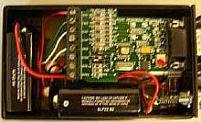
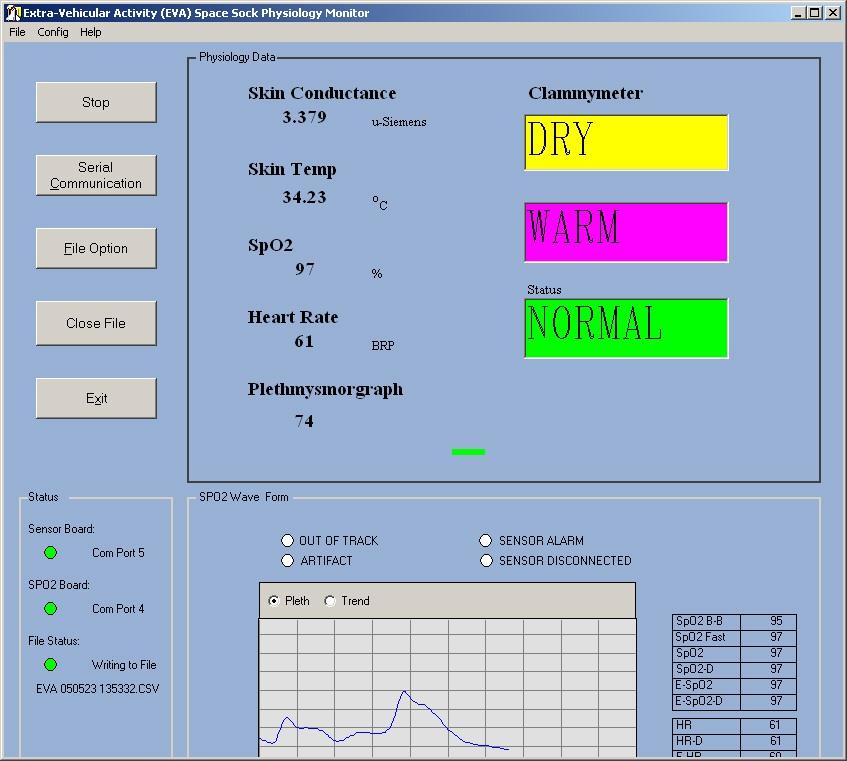
AIT has developed a small size PC-based multi-vital signal monitor. Figure 4 shows the internal circuit (a) of the device and the display interface on the computer screen (b). The device can acquire and monitor the vital signals of skin conductance, skin temperature, oxygen concentration, heart rate and plethysmography. These vital signals and parameters can be transferred to remote hospital through the Internet. The major advantages of this monitoring device are (1)Small size and light weight. It is portable and can be easily carried by the patient. Therefore, the patient can always monitor the vital parameters within the schedule time frame even he/she needs go away from home. (2)Low cost. The cost is much lower then the conventional monitor because PC is used to carried out the major signal analysis and display. It is affordable for normal people. (3)The vital parameters can be transferred to remote hospital. Physicians or hospital can remote monitoring many patients’ vital parameters on time and provide advance and medical service to the patient. (4)The changes of patients’ vital parameters can be recorded in database. The long-term change of the patient’s vital parameters can be used for follow up and comparison. The data collected from a number of patients may also easily be used for scientific study of a certain type of disease. 2.1.2 System for chronic care of diabetes As a particular application of the developed PC-based multi-vital signal monitor, AIT also developed a system for chronic care of diabetes. It is known that the diabetes conditions can be detected from the combination parameters of patient’s skin conductance (which reflects dry or wet skin) and skin temperature. Patient may be at a dangerous acute condition of diabetes if the combined parameter goes beyond normally acceptable results. The patient may loose conciseness with that acute condition and therefore, it is crucial for those patient to have a long-term monitor for the condition and need notice the health care provider for immediate attention for this patient. AIT has developed a system and associated software using the AIT’s PC-based multi-vital signal monitor to automatically calculate the combined parameter and compare it with the acceptable parameter under normal condition. The basic structure of the chronic care of diabetes monitoring system is shown in Figure 5. Patient were a set of sensors on the whist connected. The vital signals are wirelessly sent to the PC with the software interface. When the software detects an acute condition of diabetes, the device will send text message to an assigned cellular phone to alarm the person to take immediate care of the patient. The alarm signal can be sent to a few phones or to the computer in a hospital.
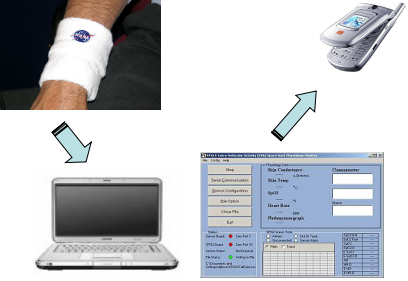
2.1.3 Falling detection device
As a part for the applications of the MIDS system, AIT has developed a falling detection device as shown in Figure 6.
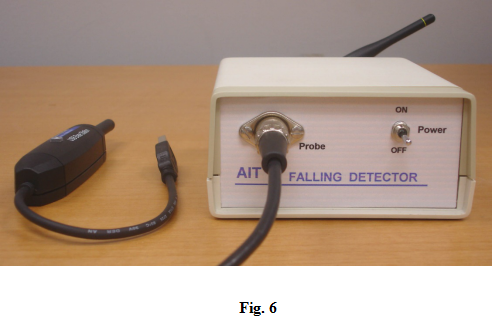
This device detects patient 3 dimensional movements with a set of acceleration sensors and wirelessly transfers the information to PC. The software installed in PC will automatically analyze the information and provide alarm signal to a cellular phone(s) and/or remote hospital for immediate care if the criteria of falling is reached from the detected signals.
2.2 The Internet-based Medical Monitoring and Diagnostic (IMMD) System
AIT is actively developing the Internet-based medical monitoring and diagnostic system. This system will use the Internet to transfer the patients’ vital parameters to a database established in a central service. Patients from homes or from hospitals can transfer their information to the server. Physicians in different hospitals can access to the database to exam the patient’s test results. In order to use different models of sensing devices for same or different vital parameters, a device called VitalPoll is developed by AIT.
2.2.1 VitalPoll device
The function of the VitalPoll device developed is to serve as a hub for digital medical signals as those used in computer work. It is able to simultannasly receive 4 channels of serial ports inputs, 2 channels of USB inputs and 2 channels of bluetooth wireless inputs as shown in Figure 7.
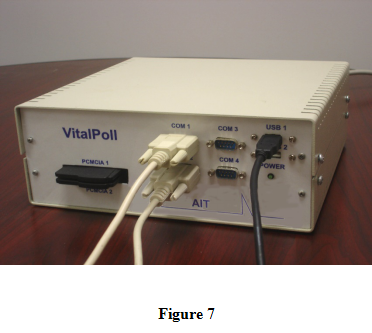
The VitalPoll receives signals from different signal sources, convert them to a standard format if the signal sources have different formats and then send the combined vitals information wirelessly to a computer which is served as VitalPoll signal manager. Employing the VitalPoll device, patient can use not only the devices developed by AIT but also the sensing devices manufactured by other companies.
2.2.2 The IMMD system
The basic structure of the IMMD system is shown in Figure 7.
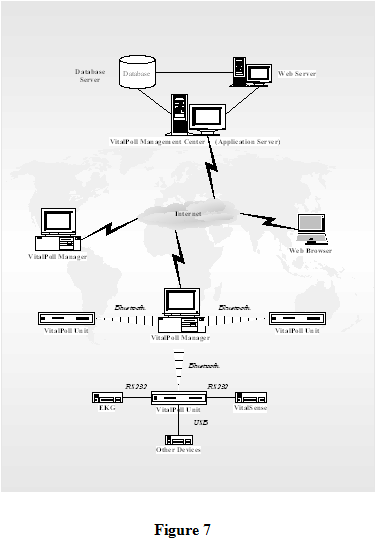
As described previously, a VitalPoll device can receive vital signals from one or several sensing devices and a VotalPoll manager can receive vitals signals from one to several VitalPoll devices. The VitalPoll managers will connect to the Internet. Combined with the central serve established in a medical center and other Internet connected computers in other hospitals, the entire IMMD system is formed.
The major functions of this system will include:
(1) Medical service and communication between patients and a main hospital or control center.
Patients can transfer basic vital parameters including skin conductance, skin temperature, concentration of oxygen, heart rate, plethysmography as well as other parameters such as blood pressure data and respiration rate etc. from home to a main hospital or control center through home computer and the Internet. The control center will monitor the parameters and perform diagnosis through local computer analysis or through physicians in local or remote hospital.
(2) Medical service and communications between two or several remote hospitals. Patients' information including the basic vital parameters, patients' data from clinical laboratory analysis, and medical images from ultrasonic scanner, CT and MRI can be transferred from one hospital to others. The video and audio signals of the physicians or patients can be transferred simultaneously. It can perform remote diagnosis and remote transferring of patients' data.
According to the American National Institute of Health (NIH), chronic medical care accounts for more than 75% of health care dollars spent in the United States. Using the developed IMMD system, the patients can be taken care at home or in a near clinic. It will provide patients especially elderly patients and patients having chronic medical conditions with much convenient medical service. It will greatly reduce the cost to patient and improve patients’ quality of life.
In August 2010, most of insurance companies in the United States placed the tele-healthcare, which includes the Internet, telephone and video relative medical services, as the payable medical service to patients. We believe that the Internet relative or PC-based medical sensing devices and the IMMD system associated with its service developed by AIT would be a hundred millions dollars market in the United States.
3Foot flexion device and other scientific instruments
Several other devices related to medical care or medical-related scientific research have also been developed and manufactured.
3.1 Foot flexion device
AIT, Inc. is in collaboration with Discovery Group, Virginia to design, manufacture and market a FDA approved product, the Flo-boot controller as shown in Figure 8. This controller is a foot flexion device to reduce the incidence of deep venous thrombosis (DVT, blood clot in veins of lower extremities).

Figure 8
Deep venous thrombosis is a relatively common but generally untreated condition. Individuals who are temporally immobilized or paralyzed can not utilize the muscles of lower leg to help pump the blood in the venous circulation back to the heat. The resultant venous blood stasis predisposes an individual to abnormal clot formation in the legs referred to as deep venous thrombosis. This condition is very common in orthopedic surgery patients who undergo joint repair or replacement of the lower extremities, in stroke patients, in general surgery patients, and any patient who is immobilized for more than 48 hours. The consequence of DVT ranges from damage and death of the body tissue that resulting to amputation of the body parts to pulmonary embolism that would result in myocardial infarction (heart attack) and eventual death. In short, DVT is a major medical problem. A device that alleviates this problem will have potential users in the millions in the US alone.
Traditionally, the means of improving venous blood flow or decreasing blood clotting include medications and a variety of compression devices. However, medications are limited by systemic side effects such as uncontrolled or internal bleeding. The compression devices include elastic compression stockings, graduated compression stockings. These devices are cumbersome and often uncomfortable to use and result in patient's none compliance. An even more serious disadvantage to such devices is the potential effects of direct compression to the arterial vasculature.
The developed Foot flexion device can be easily applied by a patient or a health care provider to a patient's foot. This device will not produce mechanical injury during restricted ankle mobility or spontaneous muscle contraction. Further more, this device is lightweight and portable, inexpensive to manufacture, and easy to operate.
This unique foot flexion device is capable of enhance blood flow in the lower extremities of individuals at risk of DVT, peripheral vascular disease and other conditions characterized by decreased circulation such as obese patients, pregnant women who experience water retention and its resultant leg swelling, individuals on medications which disturb water and electrolyte balance, and individuals simply interested in preventing or attenuating development of leg varicosities.
In particular, this device can produce all of the therapeutic benefits and additionally, is lightweight and portable, adaptable to the conscious and unconscious wearer, non-restricting to the wearer, easy to apply and remove, and inexpensive. This device is adaptable for outpatients and home care. It will have a great market in United States and other countries.
3.2 Fluid Percussion Device
AIT is in collaboration with AmScien Instruments LLC, a subdivision of AIT to design and manufacture a scientific instrument, Fluid Percussion Device.

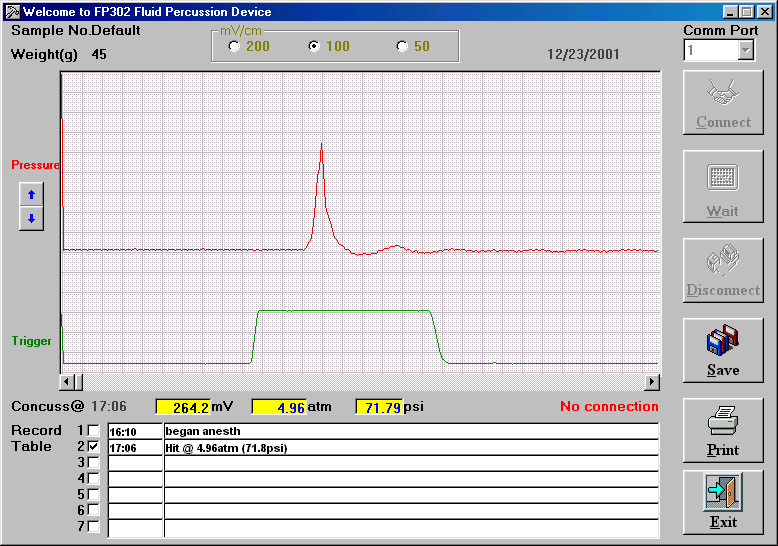
Figure 9
The main function of Fluid Percussion Device is for in vivo simulation of traumatic brain injury. The device generates controlled impact to small and medium sized animals such as rats or pigs for neurological research. The structure of this device is shown in Figure 9(a). When a controlled impact applies to the animal brain, the pressure waveform and the peak pressure will be automatically calculated and displayed in the computer screen as shown in Figure 9(b).
3.3 Pneumatic (Cortical) Impact Device
AIT is also in collaboration with AmScien Instruments LLC, to design and manufacture a scientific instrument, Pneumatic (Cortical) Impact Device.
The Pneumatic (Cortical) Impact Device is designed to provide controlled impact with rapid movement of a rod to the brain of small animals. It is also simulating traumatic brain injury for scientific and neurological research.
The structure of the device is shown in Figure 10(a). By applying a high pneumatic pressure to move a metal rod and hit the brain of animal, a traumatic model can be set up. The pressure and the duration of pressure applied to the animal will be automatically measured and displayed on the computer screen as shown in Figure 10(b).

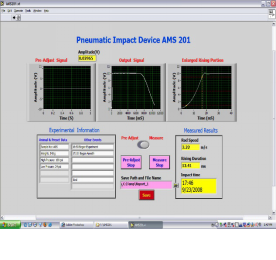
Figure 10
4Fingerprint Verification and Management System.
With the explosion of new technology and information, today more than ever, a quick and reliable method of personal verification has become a necessity through out all walks of our life. From financial activities, law enforcement, passport verifications, social benefit, medical insurance, to building, hotel room and confidential information access, an accurate personal verification is crucial. From a simple ATM or credit card transaction to a multimillion dollar business transaction, it all can be accomplished with only a few key strokes on a key board in front of a computer terminal. However, along with the convenience, customers become more vulnerable to fraud, Especially with the ever increasing number of on-line banking customers, ranging from on-line shopping to making the monthly house hold payments this problem has been greatly amplified. According to National Fraud Information Center, credit card fraud currently exceeds $1,000,000,000.00/year in U.S. A thief can clear out a customer's bank account with only his card number. On the other hand, fraudulent claims of benefits and medical insurance have caused a great deal of financial loss to the government and insurance companies.
Currently, electronic fingerprint identification system is the most promising new technology to obtain a reliable and affordable personal verification. It is well known that every fingerprint in every individual has its own unique features, and matching fingerprint images is a reliable and convenient way for personal identification.
AIT, Inc. has develops a unique fingerprint identification system. Research work and tests have been carried out for several years. This system uses state-of-the-art technologies including the biometrics detection, pattern recognition, fuzz logic, high-tech electronics and computer technologies to recognize the unique characteristics of each individual's fingerprint. This system can be easily integrated to any PC as a stand-alone system or to be connected to a network to serve as a local verification network. This system can also be connected to Internet for remote verification. More than 20,000 tests have been carried out to evaluate the reliability of the system. The excellent results have proved that our system can provide an accurate, reliable and affordable electronic personal verification solution to the banking industries, security organizations, insurance companies, and the average consumers.
4.1 Major System Features
The fingerprint verification system has a false acceptance rate less than 10-6. This is the ratio of number of incorrectly accepted fingerprints to the total number of tests in which false fingerprints are used. This extremely low ratio ensures that no unauthorized personal would gain access to our account or properties.
The system has a false rejection rate lower than 0.01. This is the ratio of the number of incorrectly rejected fingerprints to the numbers of total tests in which the correct fingerprints are used under normal application conditions. Although this rate is a little less important than the false acceptance rate, the low false rejection rate makes our system very convenience for our customers.
The total time required for the recognition process is less than 2 seconds. This includes the image capture time. The comparison of images itself would be much faster.
4.2 System Advantages
(1) Foolproof Security
Our system can provide multi-level security management. Fingerprint IC card will let only the card owner to have access. If the card is lost, the owner simply needs to obtain a new IC card from the management service. There will be no danger of fraudulent use of the owner's identity.
(2) Simply to Operate and Easy to Carry
In order to gain access, user only needs to insert the IC card into the reader and press his or her finger on to the finger print scanner. There is no PIN number or password to memorize.
(3)Fast and Dependable
Our system can verify a card holder within a few seconds with the excellent false rejection rate and false acceptance rate.
(4) User Friendly
Our software can be easily converted in to many different languages. It is menu-driven with colorful and easy to read design.
(5) Excellent Data Security
All data (i.e. fingerprint, SSN or others) placed on the IC card will be scrambled. It is virtually impossible for an unauthorized card reader to read or change the information on the smart card.